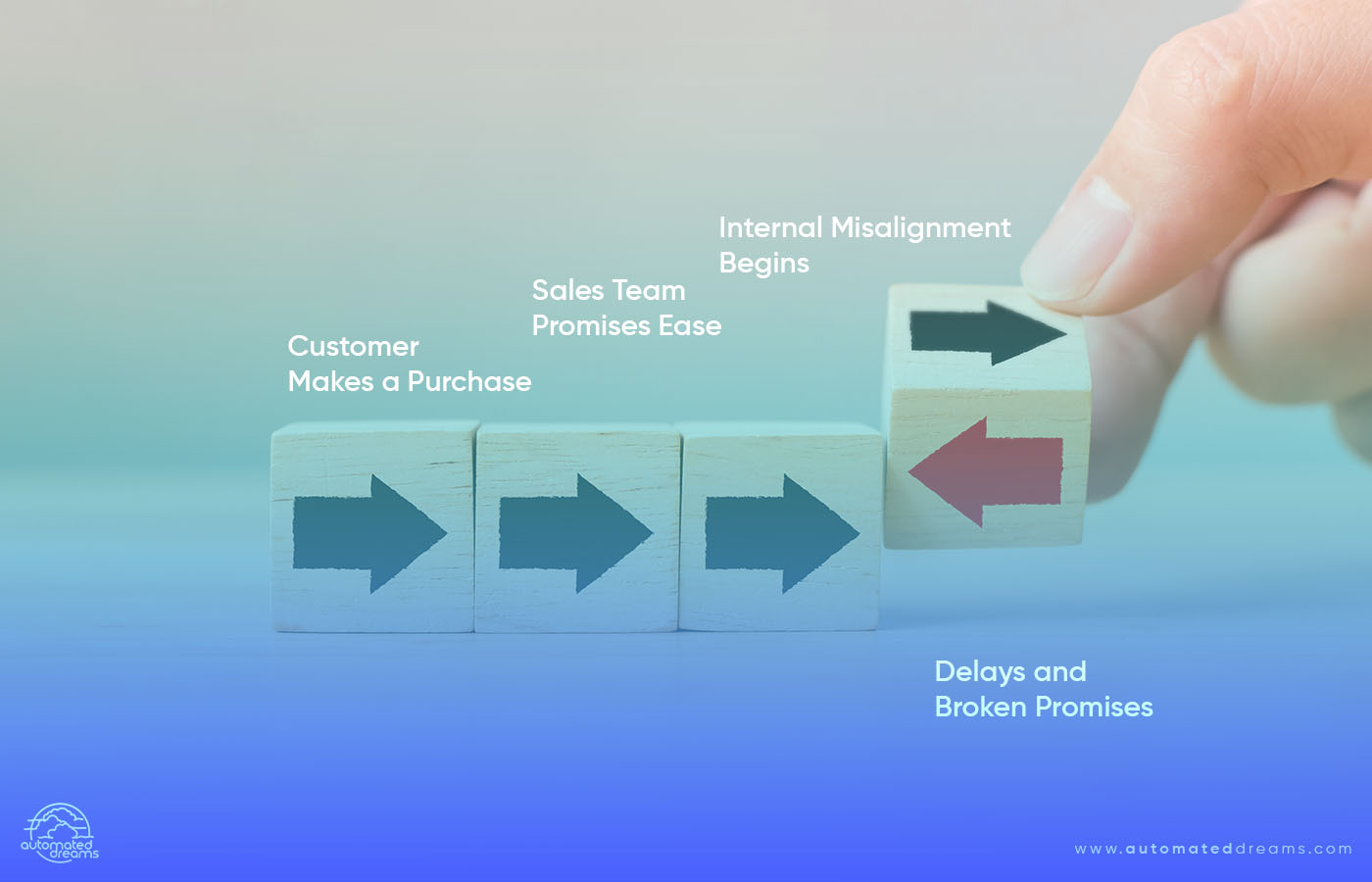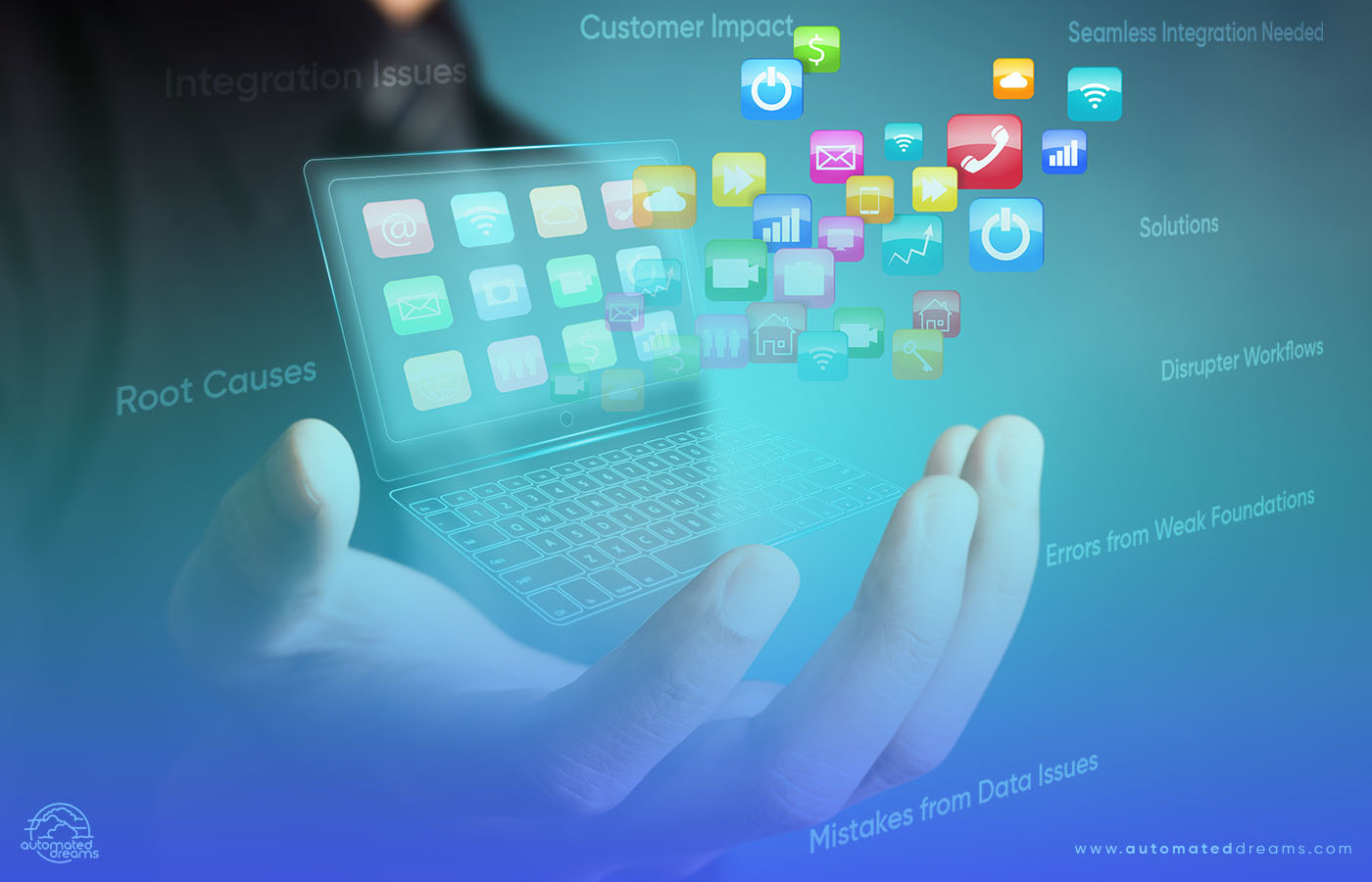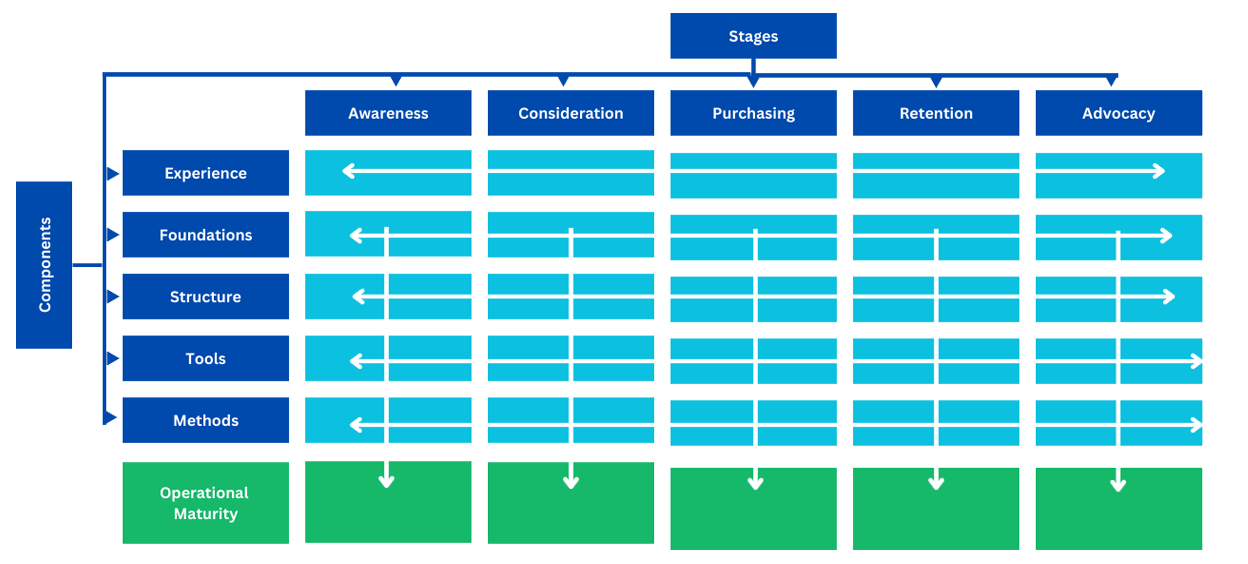The Purchasing stage of the B2B customer journey is crucial and requires extra attention to detail. Why? Subpar customer experience in the B2B Purchase stage leads to lost revenue, reduced satisfaction, and long-term brand damage. To achieve your A game, you’ll need to take a step back from the logical and lean in on the emotional and operational dynamics that are most important (but often overlooked) during the purchase process.
Forrester Research reports that companies with aligned sales and operational systems see 36% higher customer retention rates. For a business generating $50 million in revenue, a 10% improvement in retention alone could result in an additional $5 million in annual revenue.
Having interviewed and implemented business process automation solutions for 200+ clients over the past 7 years, we built a framework – The Operational Maturity and Efficiency Framework (OMEF) – that critically analyzes issues that impact customer experience at different stages of the buyer’s journey.
In this blog, we narrowed in on the top 5 Purchasing stage mistakes that hurt revenue and customer experience in B2B. 3 out of 5 business leaders are guilty of 90% of these mistakes. Read on to find out if you are.
5 Purchase-Stage Mistakes That Impact Customer Experience in B2B and How to Solve Them
1. You Fail to Consider That Purchasing Is Also an Emotional Decision

A common misstep in the purchasing stage is treating it solely as a logical transaction. B2B companies often overlook the emotional aspects of purchasing, which can lead to a disconnect between the promises made by your sales team and the capabilities of your fulfillment team. This disconnect manifests in delays, errors, and unmet expectations. It erodes trust and satisfaction.
Typically, the mistake happens this way: The customer commits by making a purchase; your sales team assures them of a smooth process; internal misalignment occurs due to siloed operations; sales and fulfillment teams work with different sets of information and objectives; the fulfillment team begins to express unclear timelines; communication starts to slow down, and promises become unfulfilled.
When we work with clients facing this challenge and analyze the situation using our OMEF, we discover that it is largely caused by weak Foundations, Structures, and Experience. A team that lacks foundational alignment (such as unclear roles and objectives), will work with fragmented structures that eventually lead to poor coordination. As a result, the customer’s emotional experience – one marked by high expectations after the sales process – is undermined by operational inefficiencies that detract from the positive emotion that was felt during the sale.
To overcome this, you must integrate your sales and fulfillment processes to ensure both teams have access to real-time customer data and a shared understanding of what every customer needs. You’ll need a centralized CRM system that can facilitate transparency and accountability and align customer expectations with the actual delivery process. You must also implement regular cross-departmental meetings to further enhance alignment and ensure that your team delivers all promises made during sales.
2. You Built Much Friction into Your Process After Customers Decide to Buy

After a customer has decided to purchase, many B2B organizations inadvertently introduce unnecessary complexity that impacts customer experience. This usually includes redundant approval steps, excessive documentation, or unclear handoff procedures. We’ve found that such friction also arises from overly complex internal policies or outdated workflows that fail to align with customer expectations. In other words, when you have a “set it and forget it” approach toward your workflows, what might have been a relatively frictionless experience becomes clogged with redundant and outdated steps. As customer expectations and industry trends continue to evolve so too should your workflows.
Our OMEF highlights weak or outdated Methods, Tools, and Experience as the major culprits of this friction. During contract negotiations, onboarding, or other final steps, B2B customers expect smooth interactions. If the Methods you use in managing these processes are no longer optimized for speed and simplicity, or your tools are fragmented or misaligned, the customer’s momentum slows down and they become frustrated. They may proceed with the purchase but you may have lost a recurring revenue potential in the process.
The solution lies in streamlining your processes – and continuing to improve them at regular intervals. To deliver impeccable customer experience in B2B Purchase stage, you must conduct a process audit to identify and remove unnecessary tasks, simplify documentation, and leverage automation tools to reduce friction. Automation tools (part of the Tools component) can handle routine actions like contract generation and approvals, while improved Methods ensure that your team regularly updates or eliminates outdated steps.
3. You Mix Too Many Tools

In an effort to manage different aspects of the purchasing process, many B2B organizations use a variety of Tools. When these tools lack integration, they create confusion and inefficiencies. Your sales teams might use one platform, while fulfillment relies on another. The result is usually data silos and disjointed workflows.
When we speak with clients facing this challenge, we discover that a combination of fragmented Tools, poorly aligned Structures, and mismanaged Foundations is usually the root cause. Your underlying structures become disjointed when you use too many Tools that don’t seamlessly integrate. We also found that weak Foundations (such as a lack of clear governance around tool selection) exacerbate this problem. Data fails to transfer smoothly between systems and causes miscommunications, errors, and duplicated efforts. For instance, if your CRM system doesn’t sync properly with your fulfillment platform, your customers will receive incorrect orders or experience delays.
To resolve this, focus on consolidating your tools, integrating your systems, and creating seamless workflows. Work towards a strong foundational approach (from the Foundations component of our OMEF) and use that as a guide for selecting and integrating your Tools so that they fit into your broader organizational strategy. You should also optimize your Structures and Experience to ensure your tools contribute to a cohesive and efficient customer experience.
4. Ease of Doing Business with You Is a Moving Target

Customer expectations are constantly evolving, and what you once considered a smooth purchasing process can quickly become outdated. As your customers become accustomed to faster, more personalized experiences, they expect the same in their interactions with you. When you fail to continuously adapt your processes, you risk falling behind more agile competitors.
On most occasions, this issue ties back to stagnant Methods, inflexible Structures, and an underdeveloped Experience strategy. When your Methods fail to evolve, you’ll lose the ability to meet rising customer expectations. Structures that remain rigid over time will prevent you from adapting quickly to changes in the market.
It becomes most noticeable when your customers start to compare their experience with other, more streamlined providers. If a once easy transaction now feels cumbersome for them, customers start seeking alternatives.
To deliver a differentiated B2B customer experience, you must embrace continuous improvement practices. Update your Methods and adopt a flexible Structure that supports innovation as they are essential in maintaining adaptability. You’ll also need to build customer feedback loops into your Experience component to keep your processes aligned with changing expectations.
5. There’s Zero Cross-Departmental Collaboration within Your Team

Silos between departments is a common challenge that impacts the customer experience in B2B organizations, particularly as they grow. When your sales, fulfillment, and customer success teams don’t communicate effectively, it creates gaps in your purchasing process and leads to delays, errors, and a disjointed customer experience.
Weak Foundations, Structures, and poorly defined Methods for cross-functional collaboration create this issue. Without clear foundational goals and structures that encourage collaboration, your teams will operate in silos and this will lead to a fragmented customer experience. The lack of Methods to ensure regular communication and alignment between various teams in your organization further exacerbates this problem.
It manifests at the handoff between departments, such as when sales closes a deal and passes the customer to fulfillment, or when customer success takes over after delivery. Without clear communication or a shared understanding, the customer experience suffers. Research shows that 80% of B2B buyers have switched suppliers due to poor customer experiences, with delays, miscommunication, and inefficient handoffs being some of the main culprits.
Overcoming this impediment requires a culture of collaboration across the entire organization. Cross-departmental projects (from the Methods component) and shared KPIs can help align your teams around the customer journey. You should also set up collaborative Tools and clearly defined Structures that can keep everyone on the same page, reduce the likelihood of errors, and improve overall customer satisfaction.
Conclusion: The Hidden Costs of Ignoring Purchase Stage Issues that Impact Customer Experience in B2B
The Purchasing stage is a critical juncture in the customer journey—one where friction, inefficiency, and a lack of alignment between departments can have far-reaching impacts on both operational performance and customer satisfaction. For businesses dealing with high-touch, complex B2B sales processes, the cost of inaction during this stage can be staggering.
Beyond the immediate revenue impact, these inefficiencies also drive up operational costs. McKinsey estimates that businesses that don’t optimize their purchasing and fulfillment processes spend an average of 25-30% more on overhead, customer service, and error management. This means that while revenue may be slipping out of your hands, you’re also bleeding resources to manage a broken system.
The cost of doing nothing is high. Every delay or misstep in the purchasing process is an opportunity for your competitors to win over frustrated customers. By taking action now, you can unlock hidden revenue, increase customer retention, and reduce operational costs.



